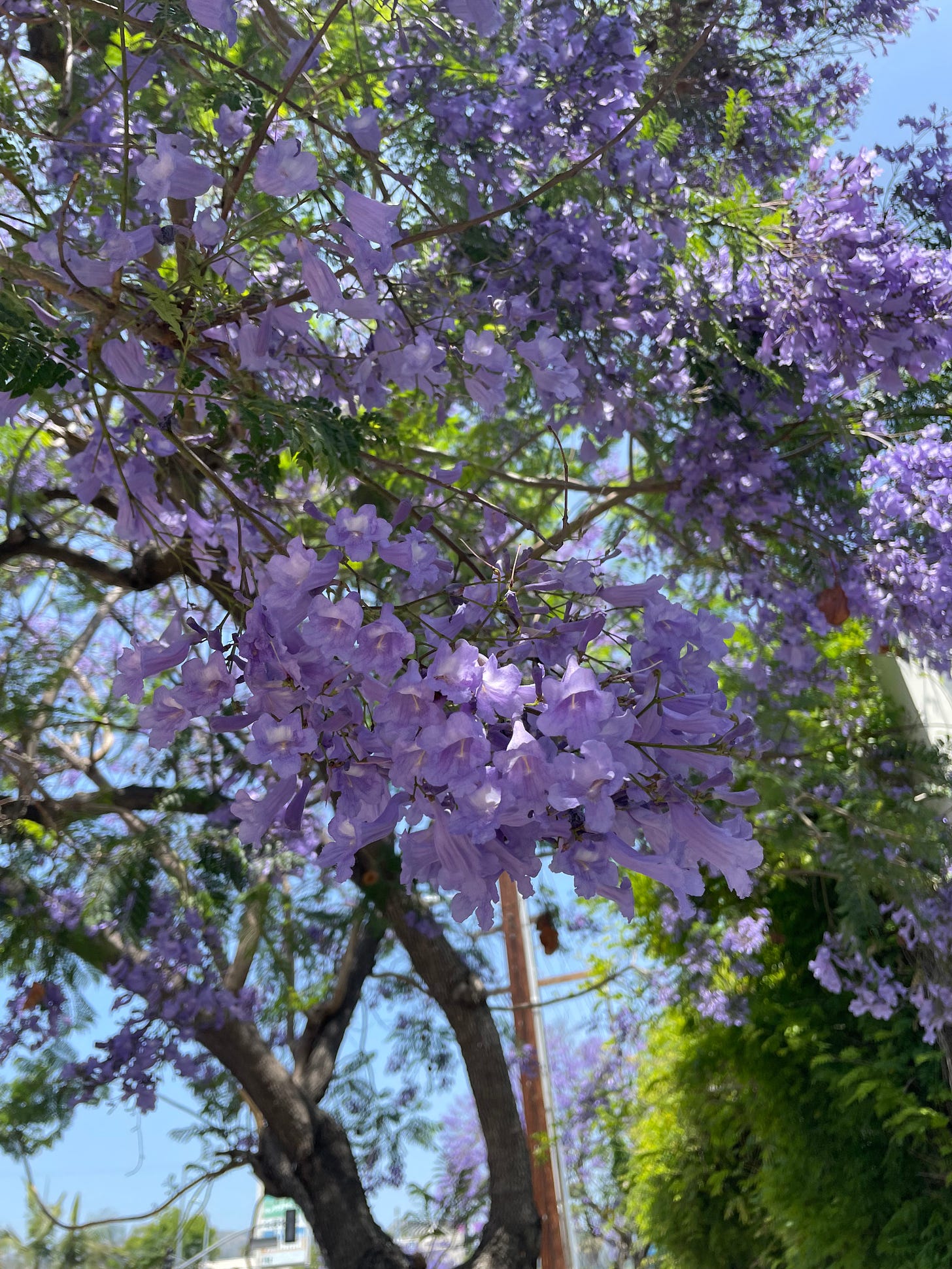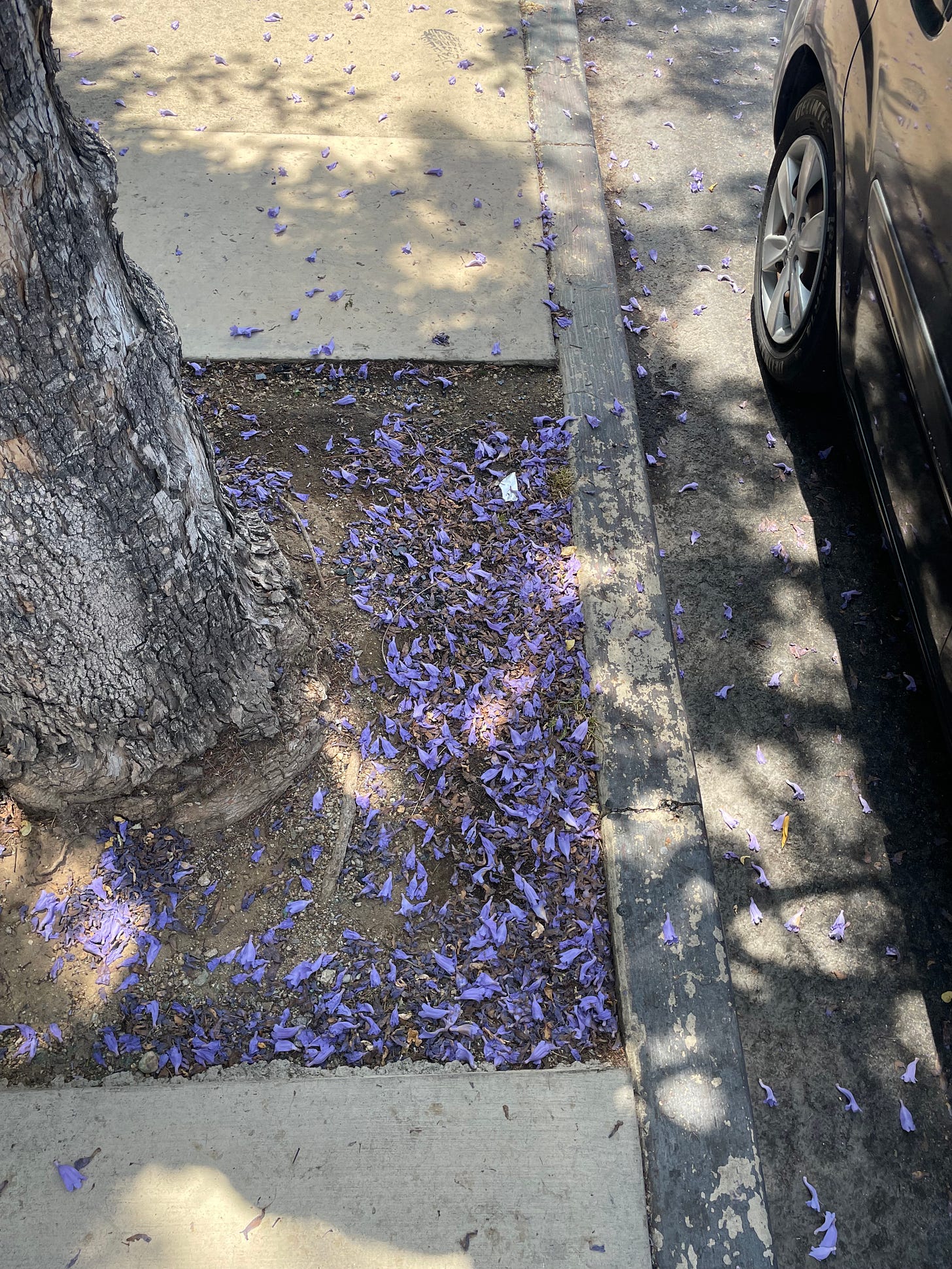Los Angeles is transforming. I wish I could say it was into a habitable city with fewer cars, more housing, and sustainable energy choices, but of course, the transformation is purely superficial. Ordinary green trees are erupting into bright purple petals, dotting hills like monochrome fireworks. These twice-yearly explosions of color are as predictable as traffic, a rare marker that yes, in fact, a season has changed. The first year I moved here my friend Kelly and I looked out over West Hollywood from the rooftop of our office’s parking garage and she said, “Yup, it’s the time of year for all the purple trees.”
It was only recently I put the proverbial two and two together and realized that “the purple trees” are Jacarandas. I knew the word from, I dunno, literature, and also from when I was bemoaning my move to Los Angeles and my New York therapist said, “It’s going to be great—the birds will be singing and the Jacarandas will be blooming!” She had more faith in me than I did in myself, which might be the mark of a good therapist.
So I knew there were these “Jacarandas” floating around, but couldn’t put my finger on exactly which strain of foliage they were. Then I read Eve Babitz and in an essay that’s about having sex for a week straight at the Chateau Marmont (she may have more than one essay about this) she described the tree in perfect detail and used its proper name. Lightbulb moment. Isn’t it crazy how we spend our days surrounded by beauty we can’t name? But then again, my cat can’t name anything, and no one can accuse him of being disconnected from his surroundings.
It’s hard to break out of precocious childhood habits, and mine is repeating new vocabulary words ad infinitum. It's partially because words are fun but mostly because when you’re a child who likes books your value is entirely tied up with other people seeing you as intelligent and you’ll do anything to maintain your fragile self-worth.
Armed with my new tree knolwedge, I found myself remarking really natural things like, “Wow, would you look at the Jacarandas?” “It’s Jacaranda season, alright.” “Hm, yea, that tree is definitely not a Jacaranda.” This was in the middle of the pandemic so the sole receptacle of this was my husband, who chose to marry me anyway.
When we thought the pandemic had ended the first time, we went to his cousin’s wedding at the Standford University chapel. In the center of the quad was a glorious blooming Jacaranda. My moment had arrived. “Would you look at that Jacaranda!” I said, addressing the assembled in-laws. Then my husband’s uncle gently pointed out the pronunciation was “Ja-caranda,” with a hard “j.” I had been pronouncing it a la espanol, “Ha-caranda.” Not quite on par with the years I confidently pronounced tangential “tangenital,” but close.
At the time I assumed this was because Jacarandas, which proliferate in South Africa, are not native to a Spanish-speaking country. But my deep research (a Wikipedia article) revealed that they’re native to Argentina. So it seems like a classic English bastardization of the correct pronunciation. This means I was right, but right only in the way an American who pronounces Barcelona “Barthelona” is right, which is not right at all.
Recently, my parents visited. My dad is a native Angeleno and my mom lived here for many years. When they saw the city abloom they started arguing about what street they remembered being lined with Jacarandas. “Pico?” “No, it was Coyne.” “It was Pico, Gail.” “No, Tom. It was Coyne.” I listened to this argument continue over the course of a week without resolution, occasionally interjecting to say, “I think it’s probably most streets in Los Angeles” only to be ignored.
I could drive around checking both, to see who was right, but it would have to be fast, because it’s not long until the purple fades back into regular green, and I wouldn’t be able to distinguish a Jacaranda from another tree if my life depended on it.





Gorgeous -- the words, and the pictures. My favorite line: "Isn’t it crazy how we spend our days surrounded by beauty we can’t name? "
Okay, this is your father, born and bred in LA, writing to set the record straight. I was the one who said Coyne, not your mother, because I LIVED on Coyne for two years when I was in grade school. Coyne was, and still is as far as I know, lined with jacarandas. Your grandmother - and almost everyone else in the neighborhood - loved the jacarandas. Except for the grouch down the street who hated cleaning up their seed pods which were an immense source of fun activities for us kids. There is even a picture (somewhere) of me sitting on top of the Coyne and Saltair street sign with jacaranda branches in view. I believe the discussion (your parents are never arguing, only passionately discussing) was happily resolved in that parts of Pico also had, and may still have, jacarandas. (Certs is a breath mint! Certs is a candy mint! Stop, you’re both right!) Like date palms, jacarandas were very widely planted around the city. The jacarandas are most certainly one of the many beautiful flora of Los Angeles that mark the change of seasons in LA that are at best under appreciated and more typically unnoticed by transplants from harsher climates - like New York, Portland, Oregon, and Palm Sorings - because the change in weather is more subtle. These neglected and ignored flora encompass a wide variety Including a wide range of succulents with truly remarkable blooms as well as many varieties of deciduous trees, such as maples, sycamores, and eucalyptuses, whose green leaves unfurl in the spring and turn color and fall during the season so appropriately named fall. Of course, many of these plants are transplants like the humans. The only difference is the plants have the good sense to adapt and enjoy the climate. They even encourage disgruntled transplants to “feel the joy” with their display of natural beauty through the year as the seasons change. Like the purple trees...